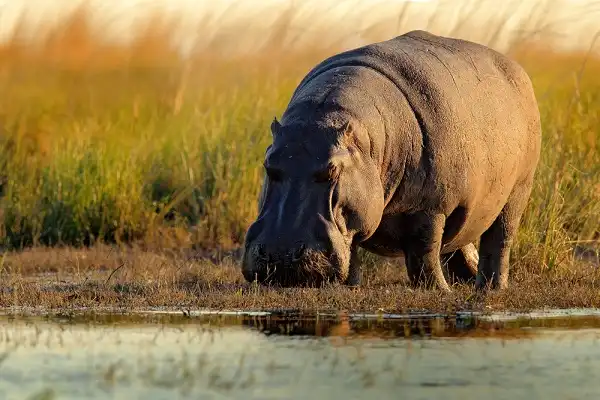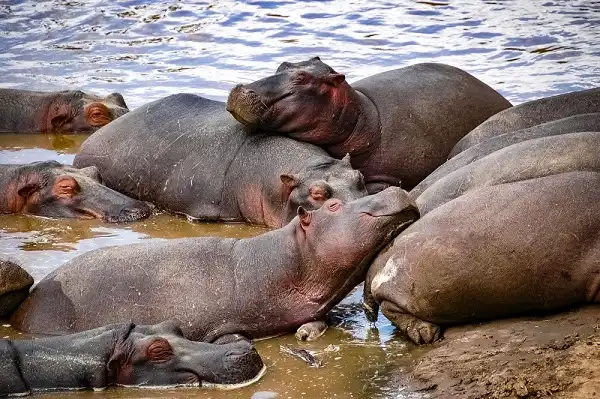Have you ever wondered what it would be like to live in Africa and see a hippopotamus in the wild? Well, I had the opportunity to travel to Africa and do just that. Seeing a hippopotamus in its natural habitat was an unforgettable experience. Here’s what it was like..

Hippopotamus Description
The hippopotamus is a large, semi-aquatic mammal native to the African continent. It is the third-largest land mammal on Earth, and its closest living relatives are whales and porpoises. The hippo’s distinguishing feature is its huge mouth, which can open up to an impressive 1.5 meters wide! Its thick skin helps protect it from predators, while its big eyes help it see better underwater. Hippos are surprisingly fast swimmers and are able to stay submerged for an impressive five minutes at a time! Hippos have unique vocalizations that range from bellows to growls and even laughs!
Hippopotamus Habitat
The hippopotamus is mainly found throughout the African continent, particularly in the savannas, floodplains and marshes of sub-Saharan Africa. They generally prefer tropical climates, but can also be found in temperate regions. Hippos inhabit both slow-moving and fast-moving rivers, lakes and swamps. In some areas they are solitary while in others they form large herds of up to 30 individuals. Hippos spend most of their time wallowing in mud or shallow water during the day, emerging at dusk to graze on grasses and aquatic plants. They are strong swimmers and can dive up to 15 meters deep! When they’re not grazing or swimming, hippos often lie on land with their mouths open to cool down or even doze off.
Hippopotamus Diet
The diet of the hippopotamus consists mainly of grasses and aquatic plants, which they graze upon for up to 8 hours a day. They are also known to feed on small mammals and birds occasionally if given the opportunity. Hippos must consume immense amounts of food each day in order to maintain their high energy levels – an adult hippo can eat up to 40kg of vegetation every day! Hippos have unique adaptations that help them find food in murky water or at night. They have incredibly sensitive noses, as well as long, muscular tongues that enable them to detect and pick out even the smallest bits of food from surrounding vegetation.
Hippos have also been observed using their powerful jaws to tear off bigger pieces of vegetation, such as reeds or branches. It’s important for hippos to maintain a balanced diet since they require large amounts of both plant material and protein for optimal health. To get enough protein, hippos often eat small aquatic animals such as frogs and fish, as well as any birds or small mammals they come across. This helps ensure they get all the nutrients they need from their omnivorous diet. The diet of hippopotamuses is not just limited to vegetation and meat – they are also known to eat fruit, seeds and insects from time to time!

Hippopotamus Size
The Hippopotamus is an incredibly large species of mammal, typically weighing between 1.5 and 4 tons and measuring between 3.3 and 5.2 meters in length! They are the second largest land mammal in the world, following only the elephant. The average adult hippo is usually around 3.5 meters long (11 feet) and 1.8 meters tall (6 feet). Female hippos tend to be smaller than males, usually weighing up to 2 tons with a body length of up to 4 meters (13 feet).
Hippopotamus Lifespan
The average lifespan of the Hippopotamus is approximately 45 years in the wild, although some have been known to live longer – up to 60 or even 70 years. In captivity, it is thought that they can live considerably longer; a hippo at the San Diego Zoo lived until she was 54! Hippos are one of the few animals that actually get larger as they age and because of this, it can be difficult to determine their true age unless you take into account other indicators such as size and fur coloration.
As a general rule, younger hippos have smoother skin compared to older individuals who may have more wrinkles with gray hairs starting to appear. This is due to the natural aging process and helps scientists to determine the age of the hippo more accurately. When it comes to reproduction, female hippos reach sexual maturity at around 4-7 years old and can produce their first calf at 6-7 years.
Male hippos tend to take a bit longer to reach maturity, usually between 5-8 years old before they are able to successfully breed. Like many wild animals, Hippopotamus populations have been declining due to habitat loss and other human activities such as hunting. It is estimated that there are only around 125,000 left in the world today so it is important that we protect these majestic creatures for future generations!

Hippopotamus Behavior
Hippos are mainly nocturnal animals, meaning they sleep during the day and come out to feed at night. During daylight hours they will often be found in large groups near rivers or lakes, basking in the sun or cooling off by taking a dip. This is especially true when it’s hot as hippos cannot sweat like us so have to stay close to water sources in order to keep their bodies cool.
In addition to being social creatures who prefer living together in large numbers, hippos also possess a unique communication system which consists of both vocalizations and bodily displays. They use these signals to show aggression towards potential rivals, indicate submission, express territorial behavior or even show affection towards one another!
Hippopotamus Speed
Hippos may look like slow and sluggish animals but they can actually be quite fast when needed. Although they are not able to maintain a consistent high speed, Hippos can reach speeds of up to 8-10 kilometers per hour while out of water and 25-30 kilometers per hour while in the water! This makes them one of the fastest mammals on land as well as underwater and why they are able to escape potential predators with ease.
Hippopotamus Hunting
Hippos are not usually hunted by humans however, they have been targeted in the past for their meat and ivory tusks. Fortunately, this practice has largely been stopped due to international laws and regulations that protect these animals from further harm. While hippos may appear intimidating at first glance, it is important to remember that these animals play an important role in maintaining healthy ecosystems across Africa and should be treated with respect. Protecting them now will help ensure that future generations can continue to admire their strength and power!

Conclusion
The Hippopotamus is a majestic and powerful creature that has been around for millions of years. Despite their imposing size, they are actually quite gentle animals who prefer to spend their days in the sun with their large families. Although hunting of these animals has decreased due to laws and regulations, it is still important to protect them in order to keep their populations safe and secure for future generations. By doing this, we can ensure the protection of one of nature’s most fascinating creatures for years to come!
Frequently Asked Question

